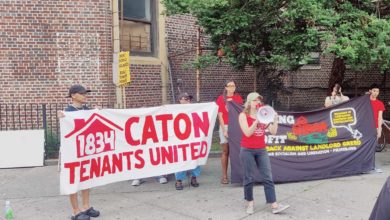Working-class residents of Queens—the New York City borough that has long been known as a bastion of affordable housing—are now finding it much harder to keep a roof over their heads. The borough’s shortage of affordable housing could soon become severe if the trends in housing construction and average home prices are not soon reversed.
From 1990 to 2000, the population of Queens grew 14.2 percent, , the largest growth in population of any New York City borough. Queens is one of the most diverse communities in the country, drawing huge numbers of immigrants from Europe, Latin America and Asia. Half of all Queens households are headed by a foreign-born person.
Across New York City over the past three years, real incomes—incomes adjusted for inflation—have steadily fallen, while rents have risen. According to a 2006 report titled “Shortchanging Working Families in Queens,” published by the Pratt Center housing advocacy group, median household incomes in Queens dropped from $48,162 in 2002 to $45,000 in 2005—more than 6 percent. Over the same period, average rents rose over 7 percent, from $886 in 2002 to $950 in 2005.
These trends have significantly increased the financial burden on working-class Queens households, including those headed by teachers and nurses—supposedly “middle-class” occupations.
Queens has the highest concentration of units that do not meet capacity regulations—a reflection of the severe overcrowding and housing crisis. Almost 9 percent of all occupied housing units in Queens were classified by the report as severely overcrowded, with the neighborhoods of Corona, Elmhurst and Jackson Heights experiencing the highest rates of severe overcrowding at 17.5 percent. According to “Shortchanging Working Families in Queens,” senior citizens and Asian, Black and Hispanic residents shoulder the highest rent burdens in the borough.
The overcrowding is not due to a lack of homes. Housing construction in Queens boomed for over a decade. More than 16,000 new housing units were built between 1994 and 2003, and in 2004 alone, over 5,000 units received residential building permits. In 2005, there were 5,371 housing starts in Queens. The Queens communities of Ridgewood and Maspeth experienced a 500 percent increase in housing starts from 2003 to 2005; Astoria saw a 300 percent increase; and Flushing, Woodside and Jackson Heights experienced a 200 percent increase, according to the 2006 report.
These homes, however, are financially out of reach for working-class Queens residents. Another 2006 Pratt Center report, “Still Subsidizing Luxury Development,” highlights 54 condominium buildings built in the last few years or currently under construction. These buildings comprise more than 6,100 high-priced luxury homes. Of these 6,100, not a single unit has a price-tag of less than $350,000, most are priced above $600,000, and some exceed $2 million.
Moreover, these new buildings are located in every borough, in working-class and oppressed neighborhoods including Riverdale, Flushing, Forest Hills, Long Island City, Corona, Brighton Beach, Bensonhurst, St. George, East Harlem, Washington Heights and Roosevelt Island. Thus, despite the economic crisis faced by millions of New Yorkers, these new developments provide not a single unit of affordable housing.
Workers’ taxes subsidize luxury housing
Adding insult to injury, the city government subsidizes these developments through the 421a Tax Abatement program, which delivers tax breaks to condominium and cooperative shareholders. Even with new limits proposed on 421a benefits, the estimated lifetime tax breaks on these buildings would still be over $500 million.
As a direct result of these development priorities, developers are planning to build 18,000 new units over the next few years. In the Nov. 1, 2006, “Queens West Issue Brief,” the Pratt Center points out that, under the current proposals, over 95 percent of this housing would be priced at the so-called “market-rate.” Only 3 percent are planned as moderate-to-middle-income units, and only 1 percent as low-income units.
The weak dollar and overall decay of the U.S economy has made New York City’s land and housing a “bargain” for international speculators and elite individuals. The demand for high-price housing remains high because of the city’s central role in global finance and entertainment. Ruling-class youth flock to the city’s more expensive districts, where they spend thousands of dollars per month on overpriced small one-bedroom and studio apartments.
Under capitalism a house, an apartment, a home is just another commodity—a “thing” to sell on the market. The need for decent affordable shelter—whether in Queens or any other place subjected to capitalism—is subordinated to the needs of the real estate developers to secure ever-greater profits.
Cuba, a country with only a fraction of the U.S gross domestic product, has virtually eliminated homelessness. Unlike the United States, Cuba is building socialism—a system that guarantees housing as a constitutionally protected social and economic right. Queens residents and all who struggle to have a roof over their heads should take note.






